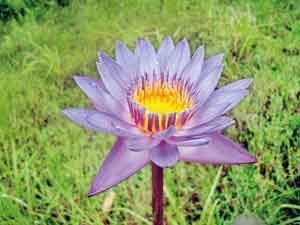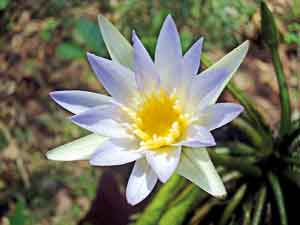Flower warriors on murky waters to victory

The imposter, Dam-manel, showing off its hybrid glory
The battle is not yet won and the warriors, covered in mud, are not ready to concede defeat……for it is all to do with the rightful National Flower being upstaged by another.
Inch by inch, the warriors who began waging war in 2011 are gaining ground and the latest victory is ‘naming’ the imposter by what it is – a hybrid – and not what it is pretending to be.
The jousting for position has been between the rightful heir, Nymphaea nouchali or ‘Nil-manel’ which has been kept from its position of National Flower by the pretender and more commonly-seen Sri Lankan Violet Water Lily or ‘Dam-manel’ (Nymphaea xerangae).
In a battle of colours, it is the difference between ‘nil’ (blue) and ‘dam’ (purple) that is the clincher, stresses warrior-botanist Prof. Deepthi Yakandawala of the Peradeniya University’s Botany Department who was the first to highlight the error surrounding the National Flower which has got entrenched in the system and not been rectified yet.
“The ‘Dam-manel’ which is widespread in natural water bodies dotting the country has been erroneously identified as ‘Nil-manel’ in the past,” she reiterates, adding that the image of this flower (‘Dam-manel’) has been wrongly depicting the National Flower for nearly three decades.

The delicately beautiful National Flower, the Nil-manel
Referring to the naming of ‘Dam-manel’, Prof. Yakandawala points out that earlier it had not been taxonomically described and as such did not have a botanical identity. To add insult to injury in the case of the National Flower that is ‘Nil-manel’, many scientific studies had been conducted on different aspects of the ‘Dam-manel’ either under “erroneous identification” or without a proper scientific name.
However, since 2010, she and husband Prof. KapilaYakandawala of the Wayamba University’s Department of Horticulture & Landscape Gardening, Faculty of Agriculture & Plantation Management, have sifted the facts from the fiction, after wading into wewas, peering at flowers and washing off the mud that is making this issue murky.
Sticking to their guns against official apathy to take heed of scientific fact which is irrefutable, the Yakandawala couple along with a post-graduate student, Shashika Guruge, has persisted with their passion.
“We continued our work from 2011 to 2016 to find the parents of ‘Dam-manel’ using morphological characters (relating to form or structure) and molecular (DNA – deoxyribonucleic acid) sequence data,” says Prof. Deepthi Yakandawala.
The study funded by the National Science Foundation to whom the researchers are ever-grateful, led to Ms. Guruge, under the guidance of the Yakandawalas, obtaining her M.Phil. This work has been published in last month’s (December) issue of the ‘Journal of the National Science Foundation’.
According to Prof. Deepthi Yakandawala at last the imposter that has been ‘Dam-manel’ has been given an identity of its own.
“Having an identity for an organism/plant is important as any aspect about it can only be communicated through its name/identity,” she says, explaining that the large attractive flowers of Nymphaea ×erangae are popular in aquatic landscapes and the aquatic cut-flower industry. These flowers are offered at Buddhist temples and shrines throughout the country and come second only to the white lotus (sudu nelum).

Professor couple Deepthi and Kapila Yakandawala brave the mud to get the facts
Pointing out that initially the plant would have been restricted to controlled landscapes, she says that it has now escaped from there and become naturalized, occurring in all parts of the island except at higher elevations. “The exotic Nymphaea ×erangae has a rapid mode of vegetative reproduction, where it is capable of producing proliferous leaves. The mature leaves of Nymphaea ×erangae are capable of developing a young plantlet at the leaf base where the petiole (the stalk attaching the leaf to the stem) meets the lamina (the leaf-blade). This has contributed to its rapid spread in local water bodies while the flawed identification as the National Flower, together with the high demand as a cut-flower has contributed to its popularity.”
Their extensive research has brought forth the following highlights:
The identification of ‘Dam-manel’ as ‘Nil-manel’ is erroneous and the use of the ‘Dam-manel’ picture as that of the National Flower is wrong.
The ‘Dam-manel’ is an exotic water lily introduced to Sri Lanka for aquatic landscaping. Even though there are no records when this outsider was brought in, evidence points to it being introduced initially well over 50 years ago.
The wrong picture of the ‘Dam-manel’ had been erroneously used as the National Flower in the official publication of the Central Environmental Authority as way back as 1992. This mistake had been widely propagated thereafter in other documentation for three decades. The National Flower had been declared in 1986.
In June 2015, the spotlight was cast clearly on this error by these scientists.
However, the abundance of the ‘Dam-manel’ in natural water bodies is making it “a mission impossible” to wrench its image off not only the official documents but also the official psyche. Although there is a Cabinet paper instructing the removal of the picture of the ‘Dam-manel’ from all official documents, there has been no action by the relevant Environmental Ministry.
The Sunday Times has spotlighted this in many articles on this issue since 2010.
| Scientific process: Everything is in a name | |
| The hybrid imposter or ‘Dam-manel’ has been named Nymphaea ×erangae after the only son of Prof. Deepthi and Prof. Kapila Yakandawala, as Eranga since childhood, has been very much a part of their team during their forays into remote villages in search of these flowers. He has undergone the same hardships as his parents in searching for the truth about the imposter. The poet may have asked: What’s in a name? But there seems to be everything in a name when it comes to the scientific process. Looking at the parentage of ‘Dam-manel’, Prof. Deepthi Yakandawala and her team have confirmed its hybrid parents as N. micrantha and N. caerulea by both morphological (relating to form or structure) and molecular (DNA) sequence data. Referring to the scientific process of ‘naming’ plants, she underscores that there is a governing body responsible for this task. It is the International Code of Nomenclature (ICN) for algae, fungi and plants and according to it, to name a hybrid plant species, the parents need to be found. It is only then that a hybrid can be named. “As our study fulfilled this requirement, we could give a name to this plant which had no identity until then. Thereafter, we named and described ‘Dam-manel’ as a new hybrid, Nymphaea ×erangae Yakandawala, Guruge & Yakandawala,” she says, adding that Nymphaea ×erangae is the name, while Yakandawala, Guruge & Yakandawala is the ‘authority’ or the botanists who gave the name. The x indicates that it is a hybrid. |


